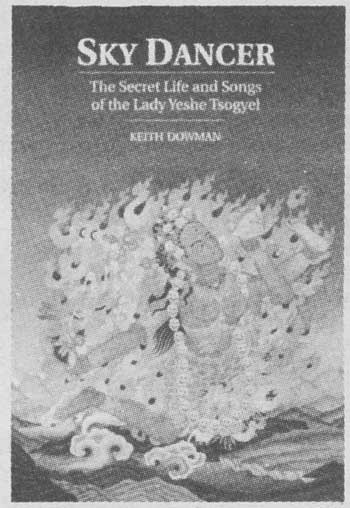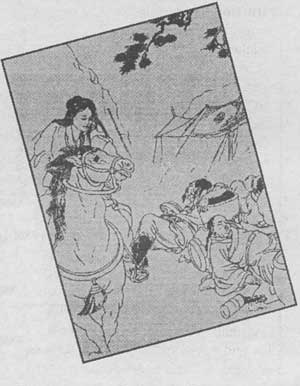| The following article is from the Summer, 1996 issue of the Snow Lion Newsletter and is for historical reference only. You can see this in context of the original newsletter here. |
The Secret Life and Songs of the Lady Yeshe Tsogyel
by Keith Dowman illustrations by Eva van Dam
379 pp., #SKDA $18.95

Yeshe Tsogyel, consort of the great guru Padma Sambhava, was one of the most famous of the enlightened women of Tibet. Women have a special place in tantra yet few works deal with the spiritual practices and evolution of female aspirants. For this reason Sky Dancer is virtually unique in the vast biographical literature of Tibet. Women are shown in an eminent position, and a path of practice is presented for initiates to emulate. Tsogyel's experiences and her detailed instructions to her disciples are inspiring for today's practitioners.
Keith Dowman lives in Kathmandu where he has spent years researching tantric traditions, translating Tibetan texts and interpreting for Western audiences.
The following is an excerpt from Chapter 4: Initiation and Instruction.
Then Guru Rinpoche entered the tantric sphere and recalled the root and branch vows. And he continued:

Hear me well, Daughter of Kharchen;
Listen attentively, revered Kuntuzangmo.
The foundation of the mahayana Tantra is the samaya vows;
If the samaya is broken we both meet disaster.
Therefore, keep these vows!
After he had spoken I swore to maintain the fundamental, root vows of the Buddha's Body, Speech and Mind, and the twenty-five branch vows. The fundament, the root samaya, is the samaya of an enlightened mind (bodhicitta): the relative bodhicitta is sealed by the absolute bodhicitta, and in order to maintain thissamaya so that I would not pass beyond the state where from the beginningiess beginning the body is actually a god, speech is the spontaneous vibration of mantra, and mind is the intangible, ultimate quality of all experience, first I took the samaya of the Buddha's Body. Here I will classify the types of master and spiritual brothers, and then explain the means of sustaining the samaya.
There are six kinds of Lama: Lamas in general, the Lama who guides us, the Lama with whom the samaya is maintained, the Lama who restores our broken vows, the Lama who liberates us from our personality and thoughts, and the Lama who gives instruction and oral teaching. Then there are four kinds of spiritual brothers: spiritual brothers in general, the close brother (who has the same Lama), the intimate brother (who has the same lineage) and the brother who is both close and intimate (having the same lineage and Lama).
Now to guard the samaya of the Buddha's Body, exoterically, the Lama is regarded as Lord and Master, or as parents, or as a loving uncle; esoterically, he is regarded like an eye, the heart, or life itself; and mystically, with body, speech and mind free of hypocrisy and dissimulation, he is identified with the Yidam deity.
To be brief, as far as physical respect is concerned, circumambulate and prostrate before your Lama and his spiritual brothers. Take care of their physical comfort like a servant or maid, and offer whatever may please them, such as food, wealth, body and possessions. To be specific, offer the same amount of respect to the Lama's relatives as to the Lama himself; respect his consort, his sons, his daughters, his parents, his spiritual brothers, yab yum, consorts and attendants and servants: thus the sacred samaya is maintained. Accordingly, obey the orders and insinuated inunctions of the Lama; refrain from any disdain towards his young acolytes, monks and patrons who perform physical service; in short, whoever the Lama loves should be respected as the Lama himselfincluding his horse, his watchdog and his menials. Again, specifically, except when the Lama, or his spiritual brothers, have extended permission, do not partake so much as a sesame seed's worth of their food, wealth or possessions, or even allow the least covetous thought regarding them to arise in the mind. Further, if you overshadow or pass over the Lama's hat, clothes, shoes, seat, bed or couch, or even his own shadow, it is said that such action is equivalent to destroying a stupa or an image of the Buddha. As a further illustration, it is said that you should not fight, kill, steal, or rob within range of the Lama's vision, even if only in jest.
Concerning verbal respect for the Lama and his spiritual brothers, if you relate whatevn faults the Lama may have to others, or exaggerate his lack of defects, if you berate him or answer him back, then whatever worship you render to the Sugatas of the microcosmic universes is to no avail, and indubitably rebirth in the Vajra-hell follows.
Concerning mental respect for the Lama, do not deceive him, do not harbour malice towards him, ridicule him, hold opinions about him, inwardly accurse him or distrust him. I myself have never once yet failed in as much as the smallest part of a hair of this samaya of the Buddha's Body, or failed in these observances of respect to the Lama and his spiritual brothers.
Secondly, the samaya of the Buddha's Speech is with the Yidam deity. I will note the three kinds of mantra and four kinds of mudra that are aspects of this samaya, and then describe the methods of maintaining the samaya. There are three kinds of mantra samaya: the samaya of the root mantra, the unfailing cause; the samaya of the creative mantra, the condition of the deity's appearance; and the samaya of the mantra that is recited to effect certain karmas. Then there are four samayas of union with the four mudra5:: the mudra of verbal commitment, the karma-mudra of Awareness, the dharma-mudra, and mahamudra.
The method of guarding this samaya is to sustain union with the mandalas of the Lama, the Yidam and the Dakini with body, speech and mind. To sustain this union there are various forms of practice suited to the capacity of the yogin. I myself practised the seven hundred thousand mandalas of the ultimate tantras that my Lama gave me, in the various modes of the superior, average and inferior yogin. The highest mode of practice, that of the superior yogin, is the Samadhi of Unqualified Pure Plea sure; the intermediate mode, that of the average yogin, is the samadhi in which light and energy forms appear as gods and goddesses; and the lesser mode, that of the inferior yogin, is identity with the Flowing River Samadhi.
On the supreme level of practice the mandala is experienced as an unbroken stream, as I experienced the Mandala of Hayagriva and Vajra Varahi. On the intermediate level of practice, the vow to meditate during six periods of seclusion, three in the day and three in the night, is rigidly maintained, as I maintained the practice of Dorje Phurba. And on the inferior level of practice, each complete basic cycle of ritesthe recitation of mantra with accompanying physical yogas, the ganacakra, etc.should receive sustained and regular application once every day, as 1 applied myself to the Sublime Accomplishment of the Eight Logos Deities (Drupa Kabje). Likewise I have never postponed even for a few minutes the practice I pledged to perform in order to sustain my attainment in numerous mandalas of other deities, whether it was according to the custom of the superior yogin who pledges to perform a prescribed amount of visualization and recitation at regular times throughout each month; according to the average yogin who practises the complete basic cycle of meditation upon a particular deity on the full moon, the dark of the moon, the eighth, tenth, and eighteenth, etc., days of the moon; according to the inferior yogin who practises one particular rite once each month; or the indolent yogin who practises a complete cycle once a year.
Thirdly, the samaya of the Buddha's Mind is the maintenance of Vision, Meditation and Action. I will define these three, and then disclose the methods of keeping this samaya: Vision is profound insight; Meditation is accomplished through experiential understanding of the nature of mind; and the Action that meditation induces is uninhibited outer, inner and mystic action.
Then the method of keeping this samaya is through secrecy: keeping the four universal secrets, the four intermediate secrets, the appropriate secrets, and entrusted secrets. The four universal secrets are the name of your Yidam, his heart mantra, his karma mantra, and your signs of mastery. The four inter mediate secrets are the place and the time and the allies and the sacred appurtenances of practice. The ritual appurtenances that the yogin relies upon in his practice of the ultimate tantras, objects that it is appropriate to keep secret, are the elements of offering, internal and mystic offerings such as sman and gtor ma, etc., manual symbols such as the bhanda, kila, khatvanga, vajra, ghanta, mala, etc., the names of the parts of the mandala, the eight adornments of the charnel ground, bone ornaments, etc., and in particular, the damaru, the kapala and the rkang-gling. Entrusted secrets are secrets concerning confidential behaviour such as the mystic practices of your spiritual brothers and sisters and the sexual behaviour of men and women in general. In short, all kinds of behaviour that it is proper to keep secret, whether of the Lama, your spiritual brothers and sisters, or of common people, should not be communicated to others.
Since I swore before my master to maintain the ten secret samayas of the Buddha's Body, Speech and Mind, the four samayas of the Buddha's Body concerning the master and spiri tual brothers, the samayas of Buddha's Speechthree of mantra and four of mudraand the samayas of the Buddha's Mindthe four universal secrets, the four intermediate secrets, the four appropriate secrets and the four entrusted secrets, I have guarded them inviolate, permitting not so much as the smallest deviation equal to a hundredth part of a hair's breadth to appear even for a split second. Further, these are the twenty-five branch samayas that Pema Jungne taught me; the samayas of the five actions that should be practisedfornication, taking what is not given, false speech, cursing and shouting; the samayas of the five substances that should be accepted gladlyexcrement, semen, meat, blood and urine; the samayas of the five realities that should be accomplishedthe Five Aspects of the Buddha, the five modes of Awareness, the Five Male Consorts, the Five Female Consorts and the five modes of the Buddha's Being; the samayas of the five emotions that should not be suppresseddesire, hatred, sloth, pride and jealousy; and the samayas of the five categories of knowledge that should be understoodthe five psycho-physical constituents, the five elements, the five sense-organs, the five sense-fields and the five colours. Having taken these branch vows in the light of extended commentary from other sources, since I have never yet come close to deviating from even a single implication of a single one of these vows for even a moment, I have been held perpetually by Orgyen Guru's compassion, remaining within the mandala of the ultimate inner tantra. And since I realised that initiation and empowerment is the key to the tantric mysteries, and that the samaya is the source of empowerment, I have maintained the samaya unbroken.
Thereafter, at Samye in Yama Lung, the Guru revealed to me the Mandala of the Tantric Mysteries, bestowing upon me the Communion of the Eight Logos Deities: the Ocean of Dharma', and we stayed there together.

